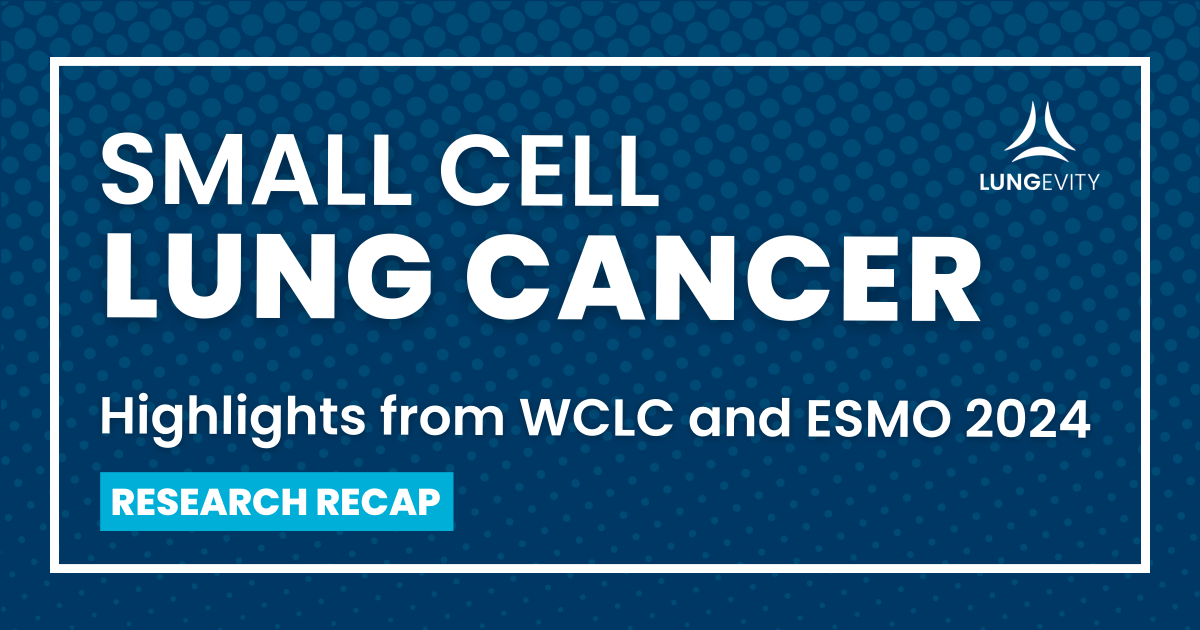This is the second blog in our series of updates from the World Conference on Lung Cancer (WCLC), held in San Diego from September 7-10, and the European Society for Medical Oncology (ESMO) conference, held in Barcelona from September 13-17. This update focuses on small cell lung cancer (SCLC), which is seen in 15% of people diagnosed with lung cancer.
You can read the other update blogs from these fall science meetings:
The treatment of SCLC depends on the stage of diagnosis. SCLC is staged as limited stage (LS-SCLC, where the cancer is restricted to one lung) or extensive stage (ES-SCLC, where the cancer has spread to the lymph nodes, to the other lung, or to other parts of the body).
Limited-Stage SCLC
Treatment for LS-SCLC is based on the size of the cancer. Most people diagnosed with LS-SCLC receive a combination of chemotherapy and radiation to the chest region. Sometimes, prophylactic intracranial irradiation (also known as PCI, consisting of radiation to the brain) is recommended, given that SCLC tends to spread to the brain. PCI takes care of micrometastases that cannot be seen through a routine brain MRI.
The recent ADRIATIC trial, presented at the American Society of Clinical Oncology (ASCO) meeting earlier this year, may soon change this standard of care. The trial showed that adding immunotherapy (durvalumab) after chemoradiation decreases the risk of cancer growing or coming back. New data suggest that the ADRIATIC treatment approach works regardless of whether someone receives PCI and once-daily or twice-daily radiation to the chest. These new findings may impact patient preferences when treatment is being discussed.
Extensive-Stage SCLC
Currently, first-line treatment for ES-SCLC is a combination of immunotherapy (durvalumab or atezolizumab) and two chemotherapies (carboplatin/cisplatin and etoposide). However, the cancer often comes back because the cells become resistant to chemotherapy. Scientists continue to push the boundaries for better first-line options. A new drug (BMS-986012) targeting the anti-fucosyl-monosialoganglioside-1 (Fuc-GM1) molecule is showing promise when combined with immunotherapy and chemotherapy.
Fuc-GM1 is found on the surface of SCLC cells and is therefore an attractive target for drug development. Trials are also looking at adding radiation treatment to the lung after a person finishes the chemotherapy portion of their treatment.
We anticipate antibody-drug conjugates (ADCs) playing a role in the treatment of ES-SCLC. ADCs are a new group of medicines made up of a monoclonal antibody chemically linked to a drug. The monoclonal antibody binds to specific proteins or receptors found on certain types of cells, including cancer cells. The linked drug enters these cells and kills them without harming other cells. ADCs targeting proteins that are found in higher levels on SCLC cells are showing promise in clinical trials. Some of these drugs (e.g., ifinatamab deruxtecan, targeting the B7-3 protein) are being developed as first-line treatment options. Others, such as sacituzumab govitecan, targeting the TROP2 protein, are being tested as second-line treatment options.
Bispecific T-cell engagers (BiTEs) are a new class of drugs that are showing promise in the treatment of ES-SCLC. BiTEs can bind to two target antigens (proteins) on the surface of different cells. For example, a BiTE may bind to a certain protein on healthy T cells (a type of immune cell) and, at the same time, to a different protein on cancer cells. This brings the T cells and cancer cells close together so that the T cells can more effectively kill the cancer cells. In SCLC, tarlatamab, a BiTE targeting the DLL3 protein on the surface of SCLC cells and the CD3 protein on T cells, has been approved for the treatment of ES-SCLC that has come back after first-line treatment. Tarlatamab is now being tested as a first-line treatment option. Other BiTEs targeting DLL3, such as BI 764532 and MK-6070, are being developed. MK-6070 seems to control the growth of brain metastasis.
Again, it's important to note that all these new drugs come with different side effect profiles that require consideration when deciding what’s best for people living with lung cancer.
Be sure to check out Dr. Stephen Liu’s talk from the International Lung Cancer Survivorship Conference on new drugs for SCLC treatment in case you missed it. You can register here to watch the video. And stay tuned for the third blog post, which will focus on advances in early-stage NSCLC.

